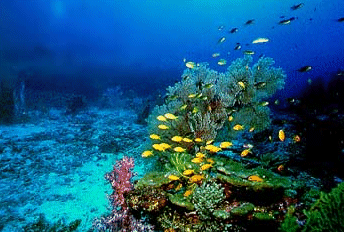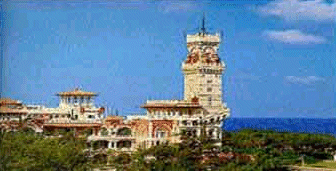
Click here to return to the One World Tours Website
holidays in egypt, egypt holidays, holidays in egypt, egypt holidays,
holidays in
egypt egypt
holidays

The Northern Coast, is the Egyptian North Western gate stretching 525 Km on the Mediterranean east to Sallum on the Libyan boarder.
This was a rain-dependent agricultural land in the Roman era. Having good faith in the prosperous future of this region, the government spares no effort to develop it. Many comprehensive planning studies have been conducted. Many luxurious tourist spots have been built. In 1978, the process was unleashed.
In spite of miles of white sand beaches and azure sea, Egypt's Med is still undeveloped and relatively unpopulated. There are fine beaches all along the coast from Alexandria to Mersa Matrouh, including the resort of Sidi Abdel Rahman, a secluded bay with clear waters and a selection of villas and hotels. At Mersa Matrouh itself, the natural bay and long white beach make for good sunbathing and swimming in calm transparent waters. Hired bicycles, carettas or open- sided tuf-tuf buses will take you to other good bathing spots nearby including the outstar beach at Al-Abyad and Ageebah cove, surrounded by beautiful scenery. As well as beaches there are other attractions in the Mersa Matrouh area :
Cleopatra's Bath, a rock-hewn whirlpool bath off- shore which was supposedly used by Antony and Cleopatra, a ruined temple fort built by Ramses II, an early Coptic chapel and "Rommel's Hideout", a cave where the general planned his military campaigns and which has now been tumed into a military museum.
At Abu Qir, a small fishing town, you can sunbath, fish, swim and eat fresh seafood. To the west of the city try the resorts of Agami or Hannoville.
Attractive integrated tourist villages are there, including beaches, houses, public service units. Moreover, 121 private locations are under study, besides the three models executed by the Ministry of construction, i.e. "Marakia", "Marabella" and "Marina" resorts.
Due to its marble-like nature, "Marakia" was originally known as "Marmarina" in the old times. The name is extracted from the Arabic word "marmar" which means marble. Clear sea and pure sand are its two main characteristics. It is 240 feddans & consists of three main parts; namely, beach, housing units and public service units. The beach is 1500 meters long; its downstream surface is 100 meters.
A pedestrain road separates it from the housing units. This stretches 400 meters, and consists of five-region on -shore 1945 units; 1267 cabins, 72 villas and 31 houses. The public service units are in both the middle of the village and at its main entrance, including administrative, emergency, communication, commercial, and entertainment services. Restaurants, cinema and an open theater. At the village entrance, a 800-person capacity mosque has been built. Large surfaces were devoted for sportive courtyards and public gardens. That is not all, there are further expansions.
One may imagine "Marina" by the meaning of its name : the beautiful sea. It is 15 Km from "Marakia", 750 meters long on the beach and its downstream surface is 800 meters. Its total surface is about 143 feddans. Many service units are constructed on the beach. The housing unit consists of 34 villas, 264 flats and 672 cabins. A center for administrative, commercial, medical, religious and entertainment services is found in the middle of the village.
El Alamein is most notable as the place where the Allied forces of WW II gained a decisive victory of the Axis forces. Today, the village located about 66 miles east of Alexandria is mostly a port facility for shipping oil. However, it was once described by Churchill as having the best climate in the world. There are several hotels and a beach resort nearby (Hotel Atic). There is also a war museum with collectibles from the Battle of El Alamein and other North African battles. The only historical interest in this village would be related to WW II, and includes an Italian and German military cemeteries on Tell el-Eisa Hill just outside of town.
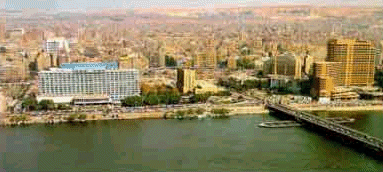
Cairo, and the area around it are considered to be the heart of Egypt, and one may find almost every aspect of Egypt represented in the area, including some of the most famous Pharaonic, ancient Christian and Islamic monuments. Cairo offers an incredible selection of shopping, leisure, culture and nightlife. Shopping ranges from the famous Khan el-Khalili souk, (or bazaar) largely unchanged since the 14th century, to modern air-conditioned centers displaying the latest fashions. All the bounty of the East is here - particularly good buys are spices, perfumes, gold, silver, carpets, brass and copperware, leatherwork, glass, ceramics and mashrabiya. Try some of the famous street markets, like Wekala al-Balaq, for fabrics, including Egyptian cotton, the Tentmakers Bazaar for appliqué-work, Mohammed Ali Street for musical instruments and, although you probably won't want to buy, the Camel Market makes a fascinating trip.
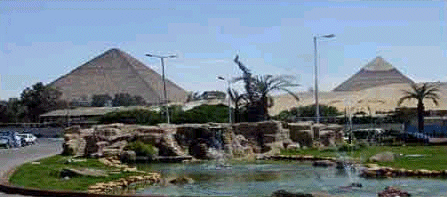
When you need a break from city life, try a round of golf on the famous Mena House course overlooking the Pyramids, watch the horse racing at the Gezira Club or visit the Zoo and the Botanical Gardens. Take a trip on the Nile in a felucca or ride on horseback from the Giza Pyramids to Sakkara. For a day trip outside Cairo visit Haraniyya village and see the beautiful tapestries and weaving produced by local people. If you wish, you may get away from it all at the top of the Cairo Tower, a modern 187 meter-high tower with views of the city from all sides, topped by a revolving restaurant.
Cairo comes alive at night, which is the best time to shop, eat delicious Middle Eastern cuisine, or simply watch the world go by from a pavement cafe. You can dine in a floating restaurant on the Nile, sample an apple-flavored shisha waterpipe at a coffee-shop or see oriental dancers and cabarets at a luxury hotel. The splendid Opera House complex houses several galleries (including the Museum of Modern Art), restaurants and concert halls. Listening to Arabic music under the stars, in the open-air theater, is a magical experience. At El-Ghuriya, in the heart of Islamic Cairo you can watch folk musicians and whirling dervish dancers. And don't forget the most essential after-dark experience, the Sound and Light show at the Pyramids, a dramatic fusion of light and music recounting the story of antiquity.
Islamic Cairo is not the oldest section of Cairo, as that distinction belongs to Old Cairo. Westerners visiting Cairo many not wish to think in terms of Islamic here, but rather medieval. Indeed this area encompasses the medieval history from beginning to end.
Old Cairo actually predates Cairo itself to old Babylon and the Romans. Located here are some of the oldest Christian Churches in the World, as well as one of the oldest Mosques.
Giza is where the Great Pyramid is located, but there is more to the west bank of the Nile. Several important districts are located here, along with wonderful restaurants and great shopping opportunities.

Hurghada was founded in the early 20th century, and until a few years ago, remained a small fishing village. But today, it has gone on to become the foremost tourist resort of the Red Sea coast and an international center for aquatic sports. If it takes place in or on the water you can do it here : windsurfing, sailing, deep-sea fishing, swimming, but, above all, snorkeling and diving. The unique underwater gardens offshore are some of the finest in the world, justifiably famous amongst divers. The warm waters here are ideal for many varieties of rare fish and coral reefs, which may also be observed through glass bottom boats. This area has many fine accommodations, usually offering warm and efficient service. Restaurants are mostly along the main road. While in Hurghada, don't miss the museum and aquarium, with their complete collections of flora and fauna of the Red Sea.
Today, Hurghada is known as a party town, particularly among Europeans. Locals and others will tell you that life begins at night in Hurghada, with the many, many clubs. They are particularly frequented by the young, but certainly many others of all ages. One may often find a rousing party centered around the visitors from a tour group taking over the action of a particular bar. They are easy to find along the main street, along with loads of inexpensive and expensive hotels.
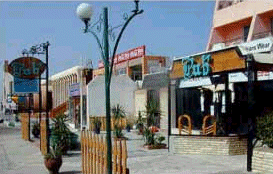
It is also a beach resort, where thousands of older Europeans and others come with their families to enjoy the sun and fun of private resort beaches, some all inclusive. Many of these hotels offer so many activities and facilities that one may never need to leave the resort. Often, the larger resorts have zoos, playgrounds, discos, bars, a number of pools and even small theaters.
Hurghada is also a city under development. Many new hotels and construction are taking place, and we can expect to see some great new hotels, restaurants and other facilities in the near future. Actually this is a busy section of the Red Sea in general. Safaga is just south of Hurghada, and Soma Bay with its beautiful Sheraton is even closer to the South. To the North is El Gouna, a highly organized resort community. Together, these communities and resort areas offer just about everything a visitor might wish for, from raucous parties to isolated scuba diving, with golf, bowling and fishing in between.
Islands near Hurghada offer all kinds of fun and excitement. Take a day trip to Giftun Island for snorkeling and a fish barbecue, or view the Red Sea from a submarine! When you're not in the sea you can shop in the boutiques, relax in the luxury holiday villages or visit the Roman Mons Porphyrites (mountain of porphyry) remains at nearby Gebel Abu Dukhan (Father of Smoke). Day-trips or safaris to explore the Red Sea Mountains by camel or jeep are also available. Other nearby islands and destinations include the Shadwan Island (Diving, snorkeling, fishing but no swimming), Shaab Abu Shiban (Diving, snorkeling and swimming), Shaab el-Erg (Diving, fishing and snorkeling), Umm Gammar Island (Diving and snorkeling), Shasb Saghir Umm Gammae (Diving), Careless Reef (Diving), Abu Ramada Island (Diving), Shaab Abu Ramada (Fishing), Dishet el-Dhaba (Beaches and swimming), Shaab Abu Hashish (Beaches, diving, snorkeling, swimming and fishing), Sharm el-Arab (Diving, swimming and fishing and Abu Minqar Island (Beaches and swimming).
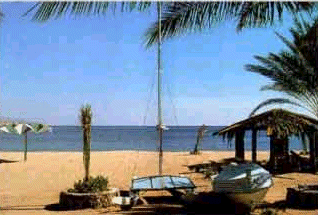
The simplicity of sun, sea and sand. The luxury of five-star hotels, water sports, shopping and entertainment. This is Sharm el-Sheikh, one of the most accessible and developed tourist resort communities on the Sinai peninsula. All around are Bedouins, colorful tents, mountains and sea. There are small, intimate hotels with modern designs, as well as larger hotel complexes belonging to International chains, plus about all the amenities one could expect of a tourist center, including casinos, discos and nightclubs, golf courses and health facilities.
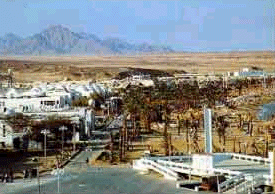
In fact, with diving and snorkeling, windsurfing and other water sports, horses and camel riding, desert safaris, and great nearby antiquities attractions, it is almost impossible for a visitor to ever suffer from boredom.
Four miles south the southern section of the town stands on a cliff overlooking the port. and is a great view.
Na'ama Beach is one of the center of the tourist activities. Located just north of Sharm, this area is developing into a resort town of its own. Most hotels at Na'ama Bay have their own, private beaches with comfortable amenities such as chairs, shades and even bars.
Shark's Bay is also nearby, and again is a growing resort community with more and more to offer, along with several diving centers.
The small harbor known as Sharm el-Moiya is located next to the civil harbor, has accommodations for boats, and includes a Yacht Club with rooms.
For those who live to shop, the Sharm el-Sheikh mall provides shops with both foreign and local products, including jewelry, leather goods, clothing, pottery and books.
It has been said that this is a must visit for all diving enthusiasts. There are many diving sites along the 10 mile beach between Sharm el-Sheikh and Ras Nusrani.
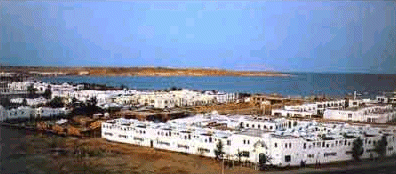
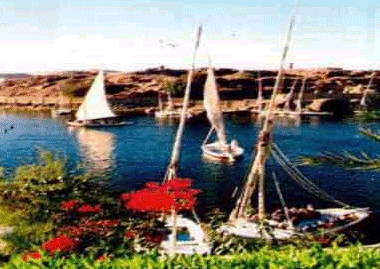
Aswan, Egypt's sunniest southern city and ancient frontier town located about 81 miles south of Luxor, has a distinctively African atmosphere. Its ancient Egyptian name was Syene. Small enough to walk around and graced with the most beautiful setting on the Nile, the pace of life is slow and relaxing. Days can be spent strolling up and down the broad Corniche watching the sailboats etch the sky with their tall masts or sitting in floating restaurants listening to Nubian music and eating freshly caught fish.
In Aswan the Nile is at its most beautiful, flowing through amber desert and granite rocks, round emerald islands covered in palm groves and tropical plants. Explore the souk, full of the scent and color of spices, perfumes, scarves and baskets. View the spectacular sunsets while having tea on the terrace of the Old Cataract Hotel (Named due to the location of the Nile's first cataract located here). Aswan has been a favorite winter resort since the beginning of the nineteenth century, and it's still a perfect place to get away from it all.
Every night Nubian dancers and musicians perform in the Cultural Center, just off the Corniche. Folklore troupes recreate scenes from village life and perform the famous Nubian mock stick-fight dances.

Aswan is a strategic location which currently houses a garrison of the Egyptian army, but which has also seen ancient Egyptian garrisons, as well as that of General Kitchener, Turkish troops of the Ottoman empire and the Romans. The city proper lies on the east bank of the Nile. Relax here, visit a few mosques, but then prepare for an adventure. The bazaar runs along the Corniche, which continues past the Ferial Gardens and the Nubian Museum, and continues on to the Cemetery, with its forest of cupolas surmounted tombs from the Fatimid period. Just east of the cemetery in the famous area quarries is the gigantic Unfinished Obelisk. Just to the south of this, two Graeco-Roman sarcophagi and an unfinished colossus remain half buried in the sand.
The most obvious is Elephantine Island, which is timeless with artifacts dating from pre-Dynastic times onward. It is the largest island in the area. Just beyond Elephantine is Kitchener's Island (Geziret el-Nabatat). It was named for the British general Haratio Kitchener (185--1916) and was sent to Egypt in 1883 to reorganize the Egyptian army, which he then led against the Sudanese Mahdi. But the island is known for its garden and the exotic plants the Kitchener planted there, and which continue to flourish today.
On the opposite shore (west bank), the cliffs are surmounted by the tomb of a marabut, Qubbet el-Hawwa, who was a local saint. Below are tombs of the local (pharaonic) nobles and dignitaries.
Upriver a bit is the tomb of Mohammed Shah Aga Khan who died in 1957. Known as the Tomb of the Aga Khan, it is beautiful in its simplicity. A road from there leads back to the Coptic Monastery of St Simeon, which was built in the sixth century in honor of Amba Hadra, a local saint.
Just up river a bit, there is also the old Aswan dam, built by the British, which was enlarged, expanded, but unable to control the Nile for irrigation.
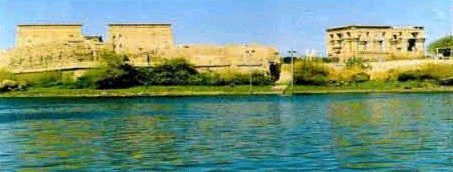
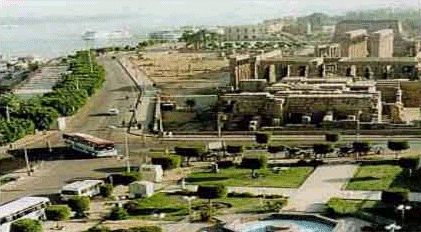
Luxor has often been called the worlds greatest open air museum, as indeed it is and much more. The number and preservation of the monuments in the Luxor area are unparalleled anywhere else in the world that know of. Actually, what most people think of as Luxor is really three different areas, consisting of the City of Luxor on the East side of the Nile, the town of Karnak just north of Luxor and Thebes, which the ancient Egyptians called Waset, which is on the west side of the Nile across from Luxor.
To say that the Luxor area is a major attraction for tourists in Egypt would be an understatement. It has been a tourist destination since the beginning of tourism. Even in ancient times, during the late Dynasties of the Greek and Roman periods, the area drew tourists, and has been doing so ever since. Today Luxor is well equipped to accommodate tourists with many hotels and in general a tourist industry ready and willing to serve the people from many countries that descend on this area of the Nile Valley every year. Within Luxor, there are only three main streets consisting of Sharia al-Mahatta, Sharia al-Karnak and the Corniched, next to the Nile. The street in front of the train station is Sharia al-Mahatta and runs away from the Nile where it meets the gardens of Luxor Temple. Sharia al-Karnak, or Maabad al-Karnak which means Karnak Temple Street runs along the Nile from Luxor Temple to Karnak Temple. However, Sharia al-Karnak is known as Sharia al-Markaz where it meets Sharia al-Mahatta street, and to the south around the temple it is known as Sharia al-Lokanda. Along this street one will find the colorful signs of restaurants and cafes, as well as bazaars where the usual variety of Egyptian souvenirs can be found. Of interest is the alabaster, which is plentiful along the west bank and miled not far from here. Also look for the clay pots used by the locals for cooking, which are more unusual.
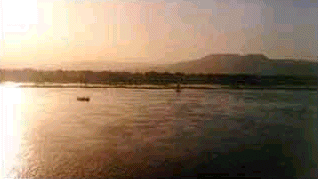
Luxor today is a city of some 150,000 people and is governed by special statues that allow it more autonomy then other political areas of Egypt. One thing you might notice is that various government and other buildings confirm to an 'ancient' building code. Particularly, the National bank of Egypt (located near the winter palace), the spa south of the police station, and the railway station are all designed to appear as pharaonic constructs. All of this occurred after the Egyptianization of the modern town resulting mostly from the mania that resulted from Howard Carter's discovery of the Tomb of Tutankhamun. As one might think, the city has all the amenities tourists might expect, including a variety of hotels, bars, nightclubs and restaurants.
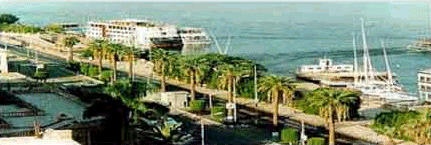
In Luxor proper on the East Bank, one of the first stops must be the Temple of Luxor built by Amenophis III. Head south on Sharia al-Karnak to reach the temple, which was connected to the Karnak Temple via a long stone processional street called a dromos. The dromos (Picture at right) was built by Nectanebo I, and originally was lined on either side by sphinxes. In front of the Luxor temple, the dromos is well preserved, and on the way to the entrance one passes by a Roman chapel of burnt brick dedicated to the god Serapis, which was built during the rule of Hadrian. There is a path that leads to the Nile side of the Temple where one enters the complex.
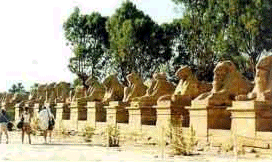
After leaving Luxor, head back to Sharia al-Karnak and go north towards Karnak. Down the road, near the police station which is near the tomb is the oldest mosque in Luxor, the El-Mekashkesh Mosque. It contains the remains of a 10th century Islamic saint who rumor has it was a monk prior to converting to Islam. The mosque is a popular pilgrimage destination. Here also is the Franciscan Church and its schools, one for boys and the other girls. Beyond this lies a great Coptic basilica.
At the Police station, head towards the Nile Corniche. Here, opposite the Mina Palace Hotel you will find the Mummification Museum, which has most anything you would ever want to know about mummifications. From here, head north towards Karnak.
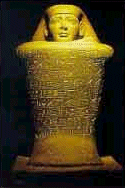
About halfway to Karnak, you will discover the Luxor Museum. (The image at left is a Block Statue of Iamu Negh from the Luxor Museum). It should certainly be visited if you plan a well rounded and educated experience. While this is a small museum, most of the relics are from the surrounding area and provide considerable insight to the monuments you will visit. From the Museum, head back to Sharia al-Karnak and continue north towards Karnak. After crossing a small bridge one will begin to see the excavated dromos off the road and running through a small village. A little further on you will pass the ruins of the Temple of Mut where another dromos leads to the gateway of the tenth pylon. The road finally arrives at the domed tombs of two saints, Sidi Ahmed and Sidi Ali, where a road leads past the Department of Antiquities leads to the main Temple of Karnak entrance. This road is built along a canal that once connected the Nile to the Temple. There was a dock in ancient times, but now all that is left is the quay and the raised dais. Just past that is a red brick Roman dock and past that two paved ramps led to the river bank. They are bordered by stone parapets, and were built during the rule of Taharqa. Past these is the Chapel of Achoris, which received the sacred boat of Amun when it was used in ceremonies.
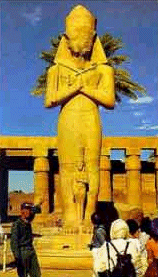
To arrive at the entrance one follows the dromos with its crio-sphinxes. They have the head of a Ram and the body of a lion and are symbolic of the God Amun. Arriving at the temple, there is a statue of Ramesses II with his son between his feet. To the right is a structure that has red steps, a red front colonnade and red brick walls. Inside there are pedestals. inscribed with the names of Roman emperors, that once held their statues. This was a Roman chapel dedicated to imperial worship. After leaving the Temple complex on the left is the Franco-Egyptian Center which has managed the temple complex since 1967. Down on the shore of the Nile is the Centre National dl la Recherche Scientifque, or CNRS, which houses the French and the Chicago House, a project of the University of Chicago is near by. After this, you will wish to take a boat trip over to the West bank. This trip had a special meaning to the Egyptians, for they were more crossing the way to the West and life, then to a necropolis. The Valley of the Kings is as good as any to try first, with tombs from the 18th and 19th Dynasties. Outside the Valley of the Kings, the road leads past Antef, named for the 11th Dynasty prices who were buried here. Some tombs can still be seen as one heads towards the Temple of Seti I. Most of what is left of Seti's Temple is the view. The court is entered by the ruined gate of a pylon The court has what is left of a palace on the south side. The road continues south passing Dra-Abu el-Naga necropolis.
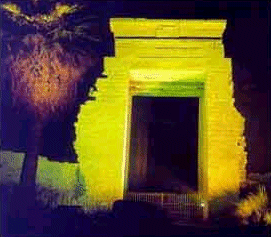
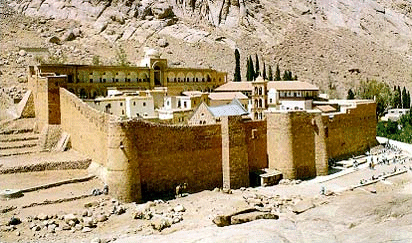
John Lloyd Stephens said that "Among all the stupendous works of Nature, not a place can be selected more fitting for the exhibition of Almighty power. Mount Sinai is both the name of a collection of peaks, sometimes referred to as the Holy Mountains, and the biblical name of the peek on which Moses received the Ten Commandments. Mount Mousa (or Musa), also referred to as Jebel Musa, Gebel Mousa, Mount Moses or the Mountain of Moses (all of which basically means the same thing) is considered to be that biblical peak. This peak has religious significance to Islam as the place where Mohammed's horse, Boraq, ascended to heaven. The 7,497 foot mountain has 3,750 steps hewn out of stone by monks of St. Catherine's Monastery, which is located just to the North. The peak is accessible by the steps, or by a gentler path east of the monastery. Both lead to an amphitheater known as the "Seven Elders of Israel". From there, one must ascend the remaining 750 steps to reach the summit where the Chapel of the Holy Trinity was built in 1934 (on the location of the original chapel built in 363 and rebuilt by Justinian in 530) and affords a truly breathtaking view. It is recommended that you take the steps down, as they will lead you past the fountain of Moses, a small chapel of the Virgin, and two arches, the Gate of St. Stephen and the Gate of the Law.
There are other peaks in this range, some of which have also been contested as the true Mount Sinai. Jebel Serbal is also a candidate. Other peaks in this range include Jebel Megafa and Jebel Moneiga.
Located at the foot of Mount Moses, St. Catherine's Monastery, was constructed by order of the Emperor Justinian between 527 and 565. It is built around what is thought to be Moses' Burning Bush, which has a chapel built atop it. It is a spectacular natural setting for priceless works of art, including Arab mosaics, Greek and Russian icons, Western oil paintings, paintings on wax, fine sacerdotal ornaments, marbles, enamels, chalices, reliquaries, including one donated by Czar Alexander II in the 19th century, and another by Empress Catherine of Russia in the 17th century. But of perhaps even greater significance is that it is one of the largest and most important collection of illuminated manuscripts in the world (The Vatican has the largest). The collection consists of some 4,500 volumes in Greek, Coptic, Arabic, Armenian, Hebrew, Slavic, Syriac, Georgian and other languages.
St. Catherine's has a rich history indeed. So rich that it is a sparkling example of an undiscovered jewel of travel. It has been called the oldest working Christian monastery and the smallest diocese in the world. The Chapel of the Burning Bush was originally ordered built by Empress Helen, the mother of Constantine the Great, but the monastery itself was actually built by Emperor Justinian to protect the monks in the region and to honor the site of the Burning Bush. St. Catherine, whose body was reportedly carried away by angels, was discovered five hundred years later at the top of the peak that now bears her name. Her relics are stored in a marble reliquary in the Basilica. We have additional pictures of this church, and of its interior.
St. Catherine's is also a formidable fortification, with granite walls measuring 8 to 35 meters tall, surrounded by gardens and cypresses. Prior to probably the twentieth century, the only entrance to St. Catherine's was a small door 30 feet high, where provisions and people were lifted with a system of pulleys, and where food was often lowered to nomads. It has withstood numerous attacks over its 14 hundred year existence, thus protecting a rich store of art. Today, while it is one of the oldest monasteries in the world, its original, preserved state is unmatched.
Though patronized during much of its history by the Russian Orthodox Church, it is now under the auspices of the Greek Orthodox Church. Most of its monks are also of Greek origin, though their ranks include an international flavor.
Petra (from the Greek, meaning 'rock') lies in a great rift valley east of Wadi 'Araba in Jordan about 80 kilometers south of the Dead Sea. It came into prominence in the late first century BCE (BC) through the success of the spice trade. The city was the principal city of ancient Nabataea and was famous above all for two things: its trade and its hydraulic engineering systems. It was locally autonomous until the reign of Trajan, but it flourished under Roman rule. The town grew up around its Colonnaded Street in the first century CE (AD) and by the mid-first century had witnessed rapid urbanization. Following the flow of the Wadi Musa, the city-center was laid out on either sides of the Colonnaded Street on an elongated plan between the theater in the east and the Qasr al-Bint in the west. The quarries were probably opened in this period, and there followed virtually continuous building through the first and second centuries CE.
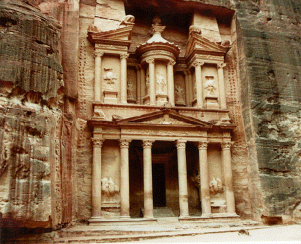
According to tradition, in ca. 1200 BCE, the Petra area (but not necessarily the site itself) was populated by Edomites and the area was known as Edom ("red"). Before the Israelite incursions, the Edomites controlled the trade routes from Arabia in the south to Damascus in the north. Little is known about the Edomites at Petra itself, but as a people they were known for their wisdom, their writing, their textile industry, the excellence and fineness of their ceramics, and their skilled metal working.
The next chapter of history belongs to the Persian period, and it is posited that during this time the Nabataeans migrated into Edom, forcing the Edomites to move into southern Palestine. But little is known about Petra proper until about 312 BC by which time the Nabataeans, one of many Arab tribes, occupied it and made it the capital of their kingdom. At this time, during the Hellenistic rule of the Seleucids, and later, the Ptolemies, the whole area flourished with increased trade and the establishment of new towns such as Philadelphia (Rabbath 'Ammon, modern Amman) and Gerasa (modern Jerash). Infighting between the Seleucids and Ptolemies allowed the Nabataeans to gain control over the caravan routes between Arabia and Syria. Although there were struggles between the Jewish Maccabeans and the Seleucid overlords, Nabataean trade continued.
With Nabataean rule, Petra became the center for a spice trade that extended from Arabia to Aqaba and Petra, and onward either to Gaza in the northwest, or to the north through Amman to Bostra, Damascus, and finally on to Palmyra and the Syrian Desert. Nabataean Classical monuments reflect the international character of the Nabataean economy through their combination of native tradition and the classical spirit.
But among the most remarkable of all Nabataean achievements is the hydraulic engineering systems they developed including water conservation systems and the dams that were constructed to divert the rush of swollen winter waters that create flash floods.
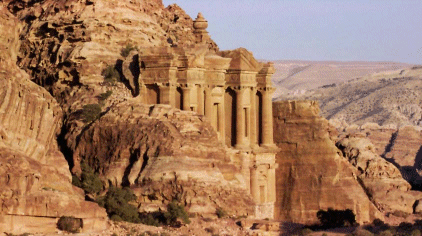
In 64-63 BCE, the Nabataeans were conquered by the Roman general, Pompey, whose policy was to restore the cities taken by the Jews. However, he retained an independent Nabataea, although the area was taxed by the Romans and served as a buffer territory against the desert tribes. Completely subsumed by the Romans under the Emperor Trajan in 106 CE, Petra and Nabataea then became part of the Roman province known as Arabia Petraea with its capital at Petra. In 131 CE Hadrian, the Roman emperor, visited the site and named it after himself, Hadriane Petra. The city continued to flourish during the Roman period, with a Triumphal Arch spanning the Siq, and tomb structures either carved out of the living rock or built free-standing. Under Roman rule, Roman Classical monuments abounded — many with Nabataean overtones.
By 313 CE (AD), Christianity had become a state-recognized religion. In 330 CE, the Emperor Constantine established the Eastern Roman Empire with its capital at Constantinople. Although the 363 earthquake destroyed half of the city, it appears that Petra retained its urban vitality into late antiquity, when it was the seat of a Byzantine bishopric. The newly excavated Petra church with its papyrus scrolls document this period, especially in the sixth century, a phenomenon less well-attested in other sites so far south of 'Amman. In this period there is also striking archaeological and documentary evidence for accommodation between Christians and the pagan aristocracy. Thereafter one can read the archaeology of a fragmented middle Byzantine community living among and re-using the abandoned limestone and sandstone elements of its classical past. The inhabitants during the Byzantine Period recycled many standing structures and rock-cut monuments, while also constructing their own buildings, including churches — such as the recently excavated Petra Church with the extraordinary mosaics. Among the rock-cut monuments they reused is the great tomb or the Ad-Dayr (known also as 'The Monastery'), which was modified into a church. With a change in trade routes, Petra's commercial decline was inevitable. An even more devastating earthquake had a severe impact on the city in 551 CE, and all but brought the city to ruin. With the rise of Islam, Petra became a backwater community. Petra was revealed to the western world in 1812 for the first time since the Crusades when it was re-discovered by the Swiss explorer Johann Ludwig Burckhardt.
As one of the most spectacular sites in the Middle East, Petra has long attracted travelers and explorers. During the 19th century, the site was visited and documented by several Europeans, after J. L. Burckhardt’s initial visit. A synthesis of the site was published by Libbey and Hoskins in 1905, presenting one of the first overviews in print. Archaeological excavations began in earnest at the turn of the century, with the earliest scientific expedition being published in Arabia Petraea in 1907, by A. Musil. In the 1920's R. E. Brünnow and A. von Domaszewski surveyed the site and published an ambitious mapping project in their Die Provincia Arabia. This survey has since undergone many necessary revisions, the most recent of which was published by Judith McKenzie in 1990.
Modern excavations continue to increase our understanding of the site and correct the work of earlier scholars. In 1958, P. J. Parr and C. M. Bennett of the British School of Archaeology began an excavation of the city center which remains the most informative and scientific to date. Recently, the Petra/Jerash Project, undertaken by the Jordanian Department of Antiquities, the University of Jordan, the University of Utah, and Swiss archaeologists, have excavated a number of monuments at these two sites. Architectural remains now visible at Petra indicate a thriving city, however, despite almost 100 years of excavation, only one-percent of the city been investigated.
The Great Temple was first explored by Brünnow and von Domaszewski, but it was Bachmann, in his revision of the Petra city plan, who postulated the existence of a “Great Temple,” aligned with the Colonnade Street, lying on the hillside to the south. He speculated that the temple was approached through a monumental Propylaeum with a grand staircase leading into a colonnaded, terraced Lower Temenos, or sacred precinct. Another broad monumental stairway led to a second, Upper Temenos. At its center was the temple, with yet another flight of stairs leading into the temple proper. While no standing structures were revealed before these excavations, the site is littered with architectural fragments, including column drums, probably toppled by one of the earthquakes which rocked the site. Given the promise of the Great Temple precinct and its importance in understanding Petra’s architectural and intercultural history, it is remarkable that it remained unexcavated until 1993 when the Brown University investigations began.
With a population of about 23,000, Siwa, the most inaccessible of all Egypt's oasis until very recently, is also one of the most fascinating, lying some 60 feed below sea level.. On the edge of the Great Sand Sea, its rich history includes a visit from Alexander the Great to consult the Oracle of Amun in 331 BC. Archaeologists, such as Liana Souvaltsis and implied that the great military leader was burried here, but no real evidence has come from this. The King of Persia lead a 50,000 man army to the area to distroy the oracle, but the entire army was lost in the desert.
The area has a nice climate, chilly in winter, hot in the summer and moderate in the spring and autumn. Lake Siwa to the west of the town of is a large, saltwater lake.
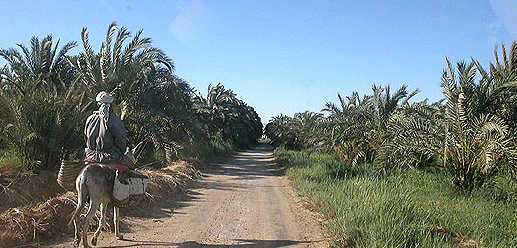
The area is famous for its dates and olives, and is one of the most beautiful landscapes in Egpt. Olives oil is still made in the area by crushing the olives from the 70,000 olive trees in the area with stones. The dates are gathered by zaggala (stick bearers), who must remain celibate until the age of forty, and the area boasts some 300,000 date trees. It is located on the old date caravan route, yet until recently, it received few other visitors and retained much of its heritage. In fact, until the battles which took place around the oasis in World War II, it was hardly governed by Egypt, and remained mostly a Berber (Zenatiya) community for the prior thirteen centuries. Siwans continue to have their own culture and customs and they speak a Berber language, called Siwi, rather than Arabic. Interestingly, each October there is a three-day festival during which Siwans must settle all of their past year's disputes.
The area is also famous for its springs, of which there are approximately 1,000. The water is sweet, and is said to have medical properties.
Though relaxing and certainly now a part of the tourist community in Egypt, it is very traditional, and visitors should keep this in mind when traveling to the area. Girls of the area are often married by the age of 14, and afterward where completely covering clothing, and allowed little communications with the world outside their immediate family. Many women still wear traditional costumes and silver jewelry like those displayed in The Traditional Siwan House museum in the town center. In fact, the area is also well known for its crafts, particularly woven cloth, which is unique in Egypt.
The Bahariya Oasis
Why pay 20 million dollars for a trip into space when you can go to the moon for so much less? OK, its not really the moon, but the landscape is surreal; alien in every way, and it changes from one moment to the next. It is the type of place that creates wonder in adults, where such feelings were long ago thought lost. It is a land not yet fully explored, with twists and turns that reveal ever changing landscapes. This is the Bahariya Oasis, and the nearby, or rather, encroaching western desert.
Over time, the Bahariya Oasis has had a number of different names. It has been called the Northern Oasis, the Little Oasis, Zeszes, Oassis Parva and the especially during the Christian era, the Oasis of al-Bahnasa, along with various other names.
At one time, the Bahariya Oasis, as well as most of the rest of what is today referred to as the Western (or Libyan) Desert, was the floor of an immense ocean. Yet from about 3000 BC until the present, almost no rainfall graces this part of the world, so groundwater is its life blood.
Remains of stone tools found in the Bahariya oasis evidence the existence of settlements in the area as early as the Paleolithic Period. In fact, we are told that anyone with a trained eye,walking about the oasis, can spot prehistoric stone knives and and axes simply lying upon the surface of the sand.
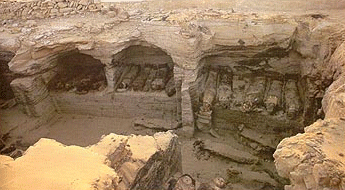
However, little real excavation has been carried out in the Oasis, at least until the last several years, and so we know little of the history of the Bahariya Oasis prior to Egypt's Middle Kingdom. What we do know comes mostly from the work of Ahmed Fakhry, and 20th century Egyptologist, who worked in the Oasis. Otherwise, most of the archaeological investigation has been carried out by the local antiquity authorities, and some recently by Zahi Hawass.
It is possible that during the Old Kingdom there may have been a governor appointed to the Bahariya Oasis, as there was in Dakhla, but so far we have no hard evidence that might support such an argument. In fact, we hear of a people known as the Tjehenu, who inhabited the Western Desert and were fair skinned with blond hair and blue eyes, and with whom the early Egyptian's fought. However, its seems that the Bahariya Oasis was originally inhabited by a mix of people from the Nile Valley and Bedouins from Libya. At that time, evidence suggests that the Oasis was much larger than it is now, but no settlements dating to the Predynastic, Early Dynastic or Old Kingdom have thus far been unearthed.
By the Middle Kingdom, Bahariya was known as Zeszes, and definitely fell under the control of the Egyptian kings, though only a single scarab (inscribed with the name of Senusret) from that period has been found in Bahariya. Yet, documentary evidence provides that both Amenemhet and Senusret II began to pay considerable attention to the Oasis, probably to deflect regular attacks from the Libyans. At that time, there must have been large agricultural estates, large houses for the landowners, and even military garrisons to keep marauders at bay. Agriculture was, as it is now, of major importance to this community, and wine, as well as other goods of the Oasis, made their way from here to the Nile Valley by donkey caravans along two different routes.
However, during the 15th Dynasty, when Egypt was under the rule of the Hyksos kings from Palestine, there was a lapse in trade with the Oasis, presumably because the trade routes were unsafe. At that time, we find only one text that refers to the Oasis, when King Kamose refers to it as DjesDjes, the word for the region's famous wine.
According to Fakhry, under Tuthmosis III, many improvements were made in the Oasis, including new water wells. His reign marked an increase in the local population. At this time, the Oasis was under the control of Thinis (Abydos), to which they paid tribute. We find visual evidence of this in the private tomb of Rekhmire, who was Tuthmosis III's vizier. One scene portrays the people of the Oasis, wearing striped kilts, presenting gifts of mats, hides and wine. However, the Oasis apparently had at least a governor who was a native of Bahariya, for the oldest tomb so far discovered in the Oasis is that of Amenhotep Huy, where his title is given as "Governor of the Northern Oasis". The tomb is dated to the end of the 18th Dynasty or the beginning of the 19th. By the 19th Dynasty of Egypt's New Kingdom, the Bahariya Oasis became even more important because of its mineral abundance. Even today, the mining of iron ore continues to be a vital industry. Even Ramesses II, in the Temple of Amun at Luxor, refers to the Bahariya as a place of mining. Of course agricultural products continued to be important in the Oasis, including dates, grapes, figs, livestock and pigeons (for food).
By the time of Merenptah, Ramesses II's son, Egypt was suffering from Libyan attacks, and the Bahariya, as well as the other Western Oasis, must have suffered considerably during this time. Ramesses III defeated the Libyans, and bought back some order to the desert region. However, it was not until the Third Intermediate Period and particularly the Late Period that Bahariya emerged as a major Egyptian center.
Shoshenq I, who founded the 22nd Dynasty under Libyan rule, along with Shoshenq IV, seemed particularly interested in the Oasis. In fact, Fakhry believed that the Libyans first captured the Farafra and Bahariya Oasis to use as a base for their conquest of Egypt. They developed the region, and ordered that government officials live in the community. We hear of an official during this period named Weshet-het, holding the title "Superior Libyan Chief", who was probably a governor, as well as another named Arcawa who became governor and priest at the end of the 22nd Dynasty. Many of its known antiquities date from this period.
Yet it was not until the 25th and 26th Dynasties that the Bahariya Oasis florished as an important agricultural and trade center. Specifically, by the 26th Dynasty, Bahariya prospered with its own governors who were natives of the oasis. They apparently continued to report to Abydos, where there apparently remained a governor over all of the Oasis. By the time of Ahmose II (570-526 BC), the importance of the Bahariya Oasis was fully understood. He sent troops into the Western Desert to defend Egyptian interests against the Greeks and Libyans, and acted vigilantly to protect this Oasis. To honor him, two temples were erected, along with a number of chapels near Ain el-Muftella (near El Bawiti). These temples were embellished even into Egypt's Persian period.
During the Persian period that followed a series of takeovers by the Nubians and Assyrians, a strong military presence and garrison were established in the Bahariya Oasis. They may have been responsible for some of the antiquities that have been attributed to the Romans. However, they could not stop the conquest of Egypt by Alexander the Great, once he decided to make Egypt his own.
It is very possible that Alexandria the Great traveled through the Bahariya Oasis on his way to the Oracle of Amun at Siwa. At first, Egypt was a organized under a centrally controlled government headed by Alexander's commander, Ptolemy, and the Bahariya Oasis immediately began to prosper. Not only were trade routes reestablished, but the Greeks used the Oasis to establish control over the rest of the Western Desert. In fact, they set up an extensive, permanent military garrison to protect the trade routes. During the Roman and Greek Periods, we seem to know more about the Bahariya Oasis than from any other period of time, though, as more archaeology is investigated, we stand to know much more. It was during the Greek period that the cemetery known as the Valley of the Golden Mummies came into existence.
This pearl of the gulf actually consists of two villages, the Bedouin village of Assalah is the southern half, with the business and administrative center of Dahab to the north. Dahab means 'gold' in Arabic. In Sinai it means golden sands, turquoise sea and off-beat cafe life. It is a focus of tourism development, with swaying palms, fine sand and wonderful snorkeling opportunities. Dahab has excellent hotel accommodations, but also affords less expensive housing in the village, or camping. About 5 miles from town is the famous Blue Hole, for diving. Towards the Israeli border is the Island of Coral, where the Crusaders built a fort. The remains can still be seen.
